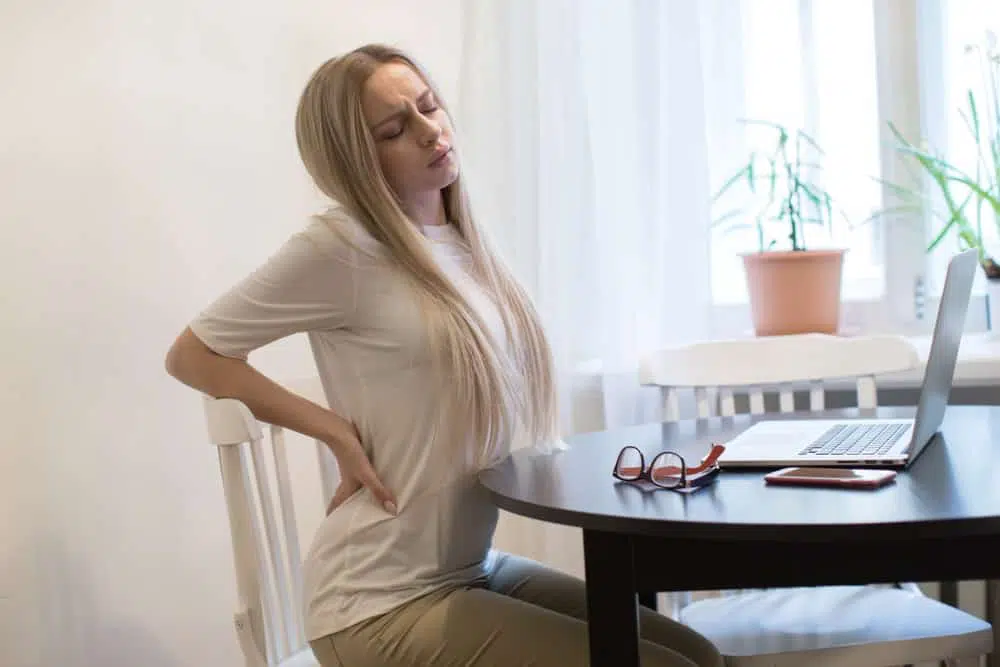Call Now!
Torrance Office: +1 (424) 360-0155

If you’re an office worker in Torrance, you’re probably no stranger to back pain. Between long hours at a desk, back-to-back meetings, and the ever-present SoCal traffic, it’s easy to develop habits that quietly wear down your spine.
According to the American Chiropractic Association, back pain is one of the most common reasons for missed work days in the U.S., affecting nearly 80% of adults at some point in their lives. For South Bay, Los Angeles professionals, where the local economy is filled with office-based jobs—from aerospace and healthcare to tech startups—these habits can lead to chronic discomfort if left unaddressed.
Let’s uncover the five bad habits most responsible for back pain among Torrance office workers—and more importantly, what you can do to fix them.

Slouching over your keyboard or leaning toward your screen might feel natural during long work sessions, but this simple habit can wreak havoc on your spine. When you hunch forward, your shoulders round, and your spine loses its natural S-curve, leading to increased strain on your lower back and neck.
According to the Cleveland Clinic, poor posture can compress spinal discs and overstretch ligaments, contributing to chronic pain and stiffness. Over time, it can even affect your breathing and energy levels.
How to Fix It:
If your office in Torrance offers ergonomic assessments or standing desks, take advantage—they’re worth every penny in long-term comfort.

Even with perfect posture, sitting for hours on end is one of the biggest culprits behind workplace back pain. The Centers for Disease Control and Prevention (CDC) highlights that prolonged sitting reduces blood flow to the back muscles and spinal discs, causing stiffness and weakness.
Torrance office workers often find themselves in long Zoom calls or focused work sessions without standing up. Unfortunately, your spine isn’t designed for that kind of stillness.
How to Fix It:
Movement is medicine—your back will thank you for it.

You can have the fanciest desk chair in the South Bay, but if it’s not set up properly, it’s doing you more harm than good. Many office workers unknowingly strain their backs due to poorly positioned equipment—such as monitors that are too low, chairs without lumbar support, or desks that are too high.
The Occupational Safety and Health Administration (OSHA) notes that improper workstation ergonomics is a leading factor in musculoskeletal disorders among office workers. These issues can develop slowly but lead to long-term pain or injury if not corrected.
How to Fix It:
A properly aligned workstation can make an immediate difference in how your back feels by the end of the day.

The human body thrives on movement, but Torrance’s busy office workers often skip exercise due to time constraints or fatigue. Unfortunately, sedentary lifestyles weaken the muscles that support your spine—especially your core and glutes—making back pain more likely.
A study published by Harvard Health found that regular stretching and strengthening exercises significantly reduce the risk of back pain among desk workers. Yet, many rely solely on weekend activities to “make up” for sitting all week, which isn’t enough.
How to Fix It:
Consistent movement throughout the week will keep your spine flexible and strong.

Mental stress doesn’t just affect your mood—it also manifests physically. When you’re under pressure, your body releases stress hormones like cortisol, which can cause muscle tightness and spasms, particularly in your neck and lower back.
According to the National Institutes of Health (NIH), chronic stress can contribute to persistent back pain by increasing muscle tension and altering posture. Torrance office workers juggling deadlines and commute stress may unconsciously hold tension in their shoulders and back.
How to Fix It:
Addressing stress isn’t just about feeling better emotionally—it’s also key to maintaining a healthy back.
1. How long should I sit before taking a break at my desk?
It’s best to stand or move every 30 minutes for 1–2 minutes (walk, stretch). Some studies show benefits, such as less upper-back/neck pain when sitting time is reduced by ~66 minutes per day.
2. Can my office chair cause permanent back damage?
A chair alone is unlikely to cause permanent damage, but poor chair settings combined with prolonged poor posture can contribute to chronic wear in discs and joints. Early action (adjustments, breaks, motion) can prevent progression.
3. Does standing more always fix my back pain from sitting?
Standing more helps reduce static load from sitting, but if your standing posture or workstation isn't set up well, or you stand in one place too long, you may still suffer. Movement and variation matter.
4. I commute long hours to Torrance — does that make my back pain worse?
Yes — long car commutes add to total sedentary time and may put your lower back in sub-optimal posture (e.g., slouched or angled seats). Making micro-breaks, using lumbar rolls in the car, and ensuring your car seat supports your spine can help.
5. If I’m only feeling mild stiffness, do I need a professional?
If the stiffness resolves with movement, breaks, and better posture, you’re doing well. But if it persists beyond 1–2 weeks, or you experience radiating pain, numbness, or weakness, it’s wise to consult a professional. Early intervention often leads to better outcomes.
6. How can I convince my Torrance employer to improve ergonomic setups?
Focus on productivity and wellness: share that employers who reduce musculoskeletal risk factors can lower absenteeism and improve comfort. Refer to the Occupational Safety and Health Administration (OSHA) and NIOSH guidance on ergonomic programs.
7. Are ergonomic chairs worth the investment if I still feel back pain?
An ergonomic chair is a valuable tool, but only part of the solution. It works best in tandem with proper posture, movement breaks, core strength/mobility work, and regular workstation reviews.
Back pain doesn’t have to be an inevitable part of office life in Torrance. By breaking these five habits—poor posture, sitting too long, ignoring ergonomics, neglecting exercise, and letting stress build up—you can significantly improve your spinal health and overall well-being.
Start with one small change today, like adjusting your chair or taking a short walk, and build from there. Your back will thank you, and so will your productivity.
